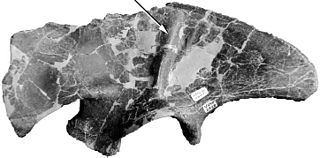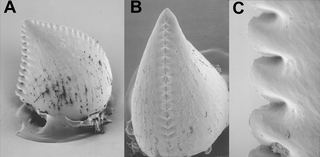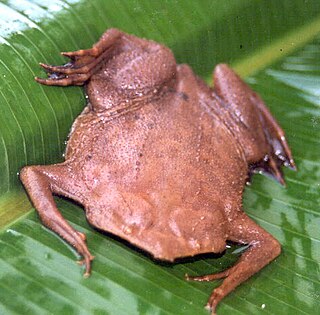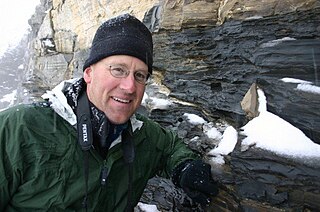Glirodon is a genus of extinct mammal from the Upper Jurassic. It was a relatively early member of the also-extinct order of Multituberculata, suborder "Plagiaulacida". These mammals lived in North America during the Mesozoic, also known as the "age of the dinosaurs".

Dryosaurus is a genus of an ornithopod dinosaur that lived in the Late Jurassic period. It was an iguanodont. Fossils have been found in the western United States and were first discovered in the late 19th century. Valdosaurus canaliculatus and Dysalotosaurus lettowvorbecki were both formerly considered to represent species of Dryosaurus.

Saurophaganax is a genus of large allosauroid dinosaur from the Morrison Formation of Late Jurassic Oklahoma, United States. Some paleontologists consider it to be a junior synonym and species of Allosaurus. Saurophaganax represents a very large Morrison allosauroid characterized by horizontal laminae at the bases of the dorsal neural spines above the transverse processes, and "meat-chopper" chevrons. It was the largest terrestrial carnivore of North America during the Late Jurassic, reaching 10.5 metres (34 ft) in length and 2.7–3.8 metric tons in body mass.

Stokesosaurus is a genus of small, carnivorous early tyrannosauroid theropod dinosaurs from the late Jurassic period of Utah, United States and Guimarota, Portugal.

Koparion is a genus of small coelurosaurian theropod dinosaur, from the late Jurassic Period, of Utah. It contains the single named species Koparion douglassi which is known only from a single isolated tooth.

Tanycolagreus is a genus of coelurosaurian theropod from the Late Jurassic of North America.

Marshosaurus is a genus of medium-sized carnivorous theropod dinosaur, belonging to the family Piatnitzkysauridae, from the Late Jurassic Morrison Formation of Utah and possibly Colorado.
Hoplosuchus is a genus of crocodyliform belonging to Protosuchidae. It is so far only known definitely from one specimen, a skeleton collected from sandstone of the Upper Jurassic-age Morrison Formation rocks at Dinosaur National Monument, Utah, during road construction. The individual was small, approximately 20 centimetres (7.9 in) long, although it may have been very young. It is the basalmost crocodyliform of the Morrison Formation, as suggested by such attributes as still having antorbital fenestrae in the skull. The limbs were relatively long, suggesting that the animal was terrestrial. Two rows of bony scutes ran down the back. The crowns of the teeth are not well preserved, so the diet cannot be determined with certainty. Given its small size, it probably ate insects and small vertebrates; it may have been carnivorous or omnivorous.

The Morrison Formation is a distinctive sequence of Late Jurassic sedimentary rock that is found in the western United States, which has a wide assortment of taxa represented in its fossil record, including dinosaur fossils in North America. It is composed of mudstone, sandstone, siltstone and limestone and is light grey, greenish gray, or red. Most of the fossils occur in the green siltstone beds and lower sandstones, relics of the rivers and floodplains of the Jurassic period.
Enneabatrachus is an extinct genus of prehistoric frogs known from the late Jurassic Morrison Formation of the United States and also the Late Jurassic-Early Cretaceous Ksar Metlili Formation of Morocco. The type species is E. hechti, whose remains have been recovered from stratigraphic zone 5.
Aploconodon is an extinct genus of Late Jurassic mammals belonging to the family Amphidontidae. It contains one species, A. comoensis.
Triconolestes is an extinct genus of Late Jurassic eutriconodont mammal from the Morrison Formation, present in stratigraphic zones 4. Known from only a single molar, it is a small mammal typically considered an amphilestid. However, it has also been compared to Argentoconodon, which has been considered a volaticothere related to gliding mammals such as Volaticotherium and Ichthyoconodon.

Opisthias is a genus of sphenodont reptile. The type species, Opisthias rarus, is known from the Late Jurassic (Kimmeridgian-Tithonian) of western North America.
Schillerosaurus was a genus of prehistoric lizard of the Late Jurassic Morrison Formation of Western North America, and is currently the only squamate genus known to be endemic to the Morrison Formation. Described based on a partial skeleton from Dinosaur National Monument by Susan Evans and Dan Chure in 1999 as Schilleria utahensis, its name was subsequently changed to Schillerosaurus due to the former name already being occupied by a modern-day arachnid subgenus.
Saurillodon is a genus of prehistoric lizard of the Late Jurassic of Portugal, UK and Morrison Formation of Western North America.
Paramacellodus is an extinct genus of scincomorph lizards from the Early Cretaceous of England and France, and the Late Jurassic of Portugal and the western United States. The type species, Paramacellodus oweni, was named in 1967 from the earliest Cretaceous (Berriasian) Purbeck Group in Dorset, England. Additional material referable to a species of Paramacellodus, possibly P. oweni, has been described from the Morrison Formation, specifically in Como Bluff, Wyoming, and Dinosaur National Monument, Utah. An indeterminate species is known from the Berriasian aged Angeac-Charente bonebed in France. Paramacellodus belongs to an extinct family of scincomorphs called Paramacellodidae, which spanned most of Laurasia during the Late Jurassic and Early Cretaceous and represented one of the earliest evolutionary radiations of lizards.
Eobatrachus is a dubious genus of extinct frog known only from the holotype, YPM 1862, part of the right humerus, found in Reed's Quarry 9 near Como Bluff, Wyoming in the Late Jurassic-aged Morrison Formation. The type, and only species, E. agilis, was named by Othniel Charles Marsh in 1887 and he initially interpreted it as a mammal, although it was later re-classified as a genus of frog related to Comobatrachus and Eobatrachus is now seen as a dubious amphibian genus, possibly belonging to Anura (frogs) according to Foster (2007).

Pipoidea are a clade of frogs, that contains the most recent common ancestor of living Pipidae and Rhinophrynidae as well as all its descendants. It is broadly equivalent to Xenoanura.

John Russell Foster is an American paleontologist. Foster has worked with dinosaur remains from the Late Jurassic of the Colorado Plateau and Rocky Mountains, Foster is also working on Cambrian age trilobite faunas in the southwest region of the American west. He named the crocodyliform trace fossil Hatcherichnus sanjuanensis in 1997 and identified the first known occurrence of the theropod trace fossil Hispanosauropus in North America in 2015.










